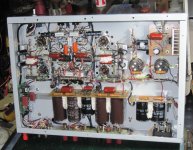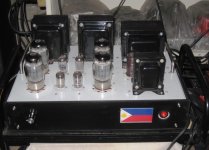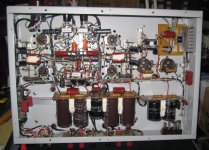Kevin, understood. I have two meters so no problem. As already suggested, both valves are likely okay -- just a matter of adjustment, since the amp was not setup by the factory. Which was the spec for the amp as ordered, so Prime amp cannot be blamed --- .except for that crazy illustration! Thanks again for all the replies and moderators for helping! steve
this is fun.....and if you can fully grasp what was discussed here, you can
apply the same learning in the future to other amps as well...
me, for amps that i intended to sell, i never use fixed biasing,
when an amp is brought to me to restore, i convince the owner
to let me modify the amp to cathode resistor biasing so that
problems like what you had is avoided during the life of the amp...
and based on client feedback, they could not hear any difference...
apply the same learning in the future to other amps as well...
me, for amps that i intended to sell, i never use fixed biasing,
when an amp is brought to me to restore, i convince the owner
to let me modify the amp to cathode resistor biasing so that
problems like what you had is avoided during the life of the amp...
and based on client feedback, they could not hear any difference...
AJT pointed out about the 450V rated filter caps....
Sorry if this is dumb but I believe the peak rating for the 450V 270uf filter caps in the power supply would be 1.4x that rating in DC terms? So those 450V rated filter caps should be okay for 500V DC? I've found 500V 270uF caps on ebay but they are bloody expensive....!!
steve
Sorry if this is dumb but I believe the peak rating for the 450V 270uf filter caps in the power supply would be 1.4x that rating in DC terms? So those 450V rated filter caps should be okay for 500V DC? I've found 500V 270uF caps on ebay but they are bloody expensive....!!
steve
i design and build my power supplies for tube amps to be able to withstand dc even with tubes out of sockets..
having said this, you can series connect two 300 volt dc caps, they should be cheaper.
with 330k 3 watt resistors across each cap and you are good to go...
there is plenty of room inside the chassis...
this is a 6550 pp amp i did...
having said this, you can series connect two 300 volt dc caps, they should be cheaper.
with 330k 3 watt resistors across each cap and you are good to go...
there is plenty of room inside the chassis...
this is a 6550 pp amp i did...
Attachments
Dear all, greetings from Germany. I found a very usefull thread in one of our forums about this tube amp with lot´s of information and modifications.
Have a look !: Der FU-29/GU-29 Thread / Audioromy M-828A & Co., Röhrengeräte - HIFI-FORUM
and use google translator...
In addition I found another great source for modifications and hint´s. I modified my audioromy already and implemented the LM317 modification which limits the bias of the FU tubes to constant 53mA. No more bias adjustment, no more red plate ! Easy to change the output tubes - the only adjust you have to do is balance.
Have a look at: SM2YER Goran's Homepage
Thank you goran for all this nice little tweaks and documentation !!
Best regards,
Peter aka copperfield
Have a look !: Der FU-29/GU-29 Thread / Audioromy M-828A & Co., Röhrengeräte - HIFI-FORUM
and use google translator...
In addition I found another great source for modifications and hint´s. I modified my audioromy already and implemented the LM317 modification which limits the bias of the FU tubes to constant 53mA. No more bias adjustment, no more red plate ! Easy to change the output tubes - the only adjust you have to do is balance.
Have a look at: SM2YER Goran's Homepage
Thank you goran for all this nice little tweaks and documentation !!
Best regards,
Peter aka copperfield
AJT pointed out about the 450V rated filter caps....
Sorry if this is dumb but I believe the peak rating for the 450V 270uf filter caps in the power supply would be 1.4x that rating in DC terms? So those 450V rated filter caps should be okay for 500V DC? I've found 500V 270uF caps on ebay but they are bloody expensive....!!
steve
Sorry for the very late reply, but I could not in good conscience leave the question unanswered.. So no, the 450V rating is the absolute maximum voltage that can be applied across the capacitor and this includes DC and any AC component present (ripple).
Conservative design practice would recommend 10 - 20% voltage derating (manufacturer usually will provide some guidelines specific to their construction/chemistry and rating scheme for derating if you dig for it). Unfortunately in many cases that significantly increases the cost.
You also need to allow for the effects of high line and usually an allowance of 10% is made.
If the manufacturer specifies a maximum surge voltage and a maximum operating voltage, the maximum operating voltage at high line should not exceed the rating in actual (not warm up) operation. Where no surge rating is given the capacitor should not be allowed to operate beyond rated voltage.
There may be more or less margin built in depending on the manufacturer, the problem is you won't know until a failure occurs (usually a bulging or exploding capacitor) so it is good to design so that the voltage, ripple current, and temperature ratings are not approached in normal operation.
As a guide for 450V caps I typically try to keep them in the vicinity of 400 - 410V at nominal line, knowing that my maximum line voltage (monitored very long term) has never been > +5%.
^Wisdom!
I will add that I also consider what will happen if I power an amplifier up with no tube installed. Say we have a node that should sit at 410V DC and the startup voltage is 470V. With tubes installed, we can look for caps that have a surge rating that will cover this, but you'll still be left with the "what if" the amp is powered up with no tubes and just left like that.
One strategy that could be examined is a string of zener diodes to yank that rail down to 450V until things warm up.
I will add that I also consider what will happen if I power an amplifier up with no tube installed. Say we have a node that should sit at 410V DC and the startup voltage is 470V. With tubes installed, we can look for caps that have a surge rating that will cover this, but you'll still be left with the "what if" the amp is powered up with no tubes and just left like that.
One strategy that could be examined is a string of zener diodes to yank that rail down to 450V until things warm up.
Last edited:
- Status
- This old topic is closed. If you want to reopen this topic, contact a moderator using the "Report Post" button.
- Home
- Amplifiers
- Tubes / Valves
- Help!!! My Audioromy FU29 amplifier was fried!



